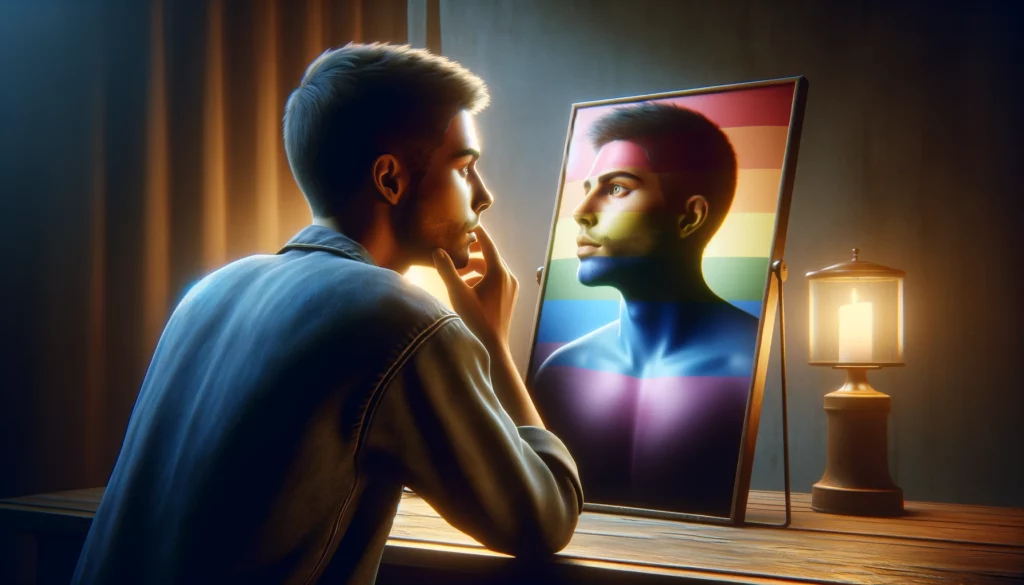Table of Contents

How Do I Know If I’m Bisexual? Introduction
Discovering your sexual orientation can be a complex journey full of questioning and self-reflection. For some men, understanding their feelings of attraction to multiple genders leads them to identify as bisexual. While every person’s experience is unique, there are some common ways men explore their sexuality and realize they may be bisexual.
Examining your attractions
Paying close attention to who you find yourself physically, emotionally and romantically attracted to can provide clues about your orientation. Some signs could indicate bisexuality:
- Finding people of multiple genders sexually appealing, not just one.
- Catching feelings for or being fascinated with friends, celebrities or others of various genders.
- Feeling drawn to women in some ways and men in other ways. Attractions aren’t necessarily identical across genders.
- Recognizing a capacity for desire and intimacy with people regardless of their gender.
- Having a fluctuating bisexual “cycle” – shifting between masculine and feminine crushes.
Trust your inner truth about who intrigues and excites you. Don’t ignore or invalidate same-gender attractions you uncover.
Exploring your desires
Exploring your fantasies can also help uncover bisexual yearnings you may not have been consciously aware of before.
- Do you find yourself imagining or dreaming about sexual scenarios with multiple genders?
- Does same-gender erotic material arouse you, even if you don’t seek it out?
- Does a small part of you wonder what sexual activity with another gender would feel like?
Don’t feel ashamed for having these desires. Being open to traditionally taboo thoughts could signal bisexual tendencies.
Assessing your sexual history
While not definitive, looking back on your past relationships and encounters may reveal bisexual patterns.
- Did a seemingly heterosexual experience have subtle same-gender undertones you brushed off?
- Did you have a sexual relationship or affair with someone of the same gender but rationalize it away?
- Have you always been curious about or a little preoccupied with same-gender experiences?
Don’t deny past evidence of bisexual behaviour, even if it was covert or you were in denial at the time.
Paying attention to envious feelings
If you find yourself occasionally envious of or wanting to emulate traits of another gender, it could reflect latent bisexual attraction.
- Do you sometimes wish you could trade bodies or lives with an attractive person of the same gender?
- Do you find yourself drawn to mimicking same-gender celebrities and media figures subtly, like style choices?
Though not consciously sexual, this envy may betray hidden same-gender longings and bisexual tendencies within yourself waiting to be embraced.
Considering the previous questioning
Have you questioned your sexuality before but talked yourself out of it or repressed it? Looking back, what led to those initial suspicions?
- Did you develop intense same-gender bonds that felt different from regular friendship?
- Were you preoccupied for a time with trying to prove your heterosexuality, perhaps defensively?
- Did you have anxiety about seeming too feminine or admit to non-stereotypical masculine behaviours?
Reexamining why you questioned in the past can help you determine if those inklings of bisexuality persist. Don’t let past repression override what your gut was telling you.
Deciphering dreams and fantasies
Dreams often reveal subconscious feelings and latent desires. Examining any same-gender dreams could provide insight into bisexual leanings.
- Do you have periodic erotic dreams about same-gender partners that leave you confused?
- Have dreams of intimacy with a man ever felt exciting or fulfilling?
- Do you have romantic dreams about a gender you don’t consciously have attraction towards?
These visions offer a glimpse into inner truths your waking mind may try to deny. Don’t discount their potential significance.
Tuning into emotional cues
Listen closely to your emotional responses around people of different genders for hints about bisexual affinities.
- Does feeling the touch, body language, or energy of someone of the same gender oddly excite you?
- Do you feel disappointed if same-gender flirting goes nowhere?
- Does an attractive stranger of a particular gender make you bashful or fill you with adrenaline?
Honour these feelings; don’t convince yourself they mean nothing. Your emotions expose who you truly desire.
Considering intimacy and relationships
For partnered men considering their sexuality, reflect on how your relationship experiences and priorities might point to being bisexual.
- Have you felt something missing from heterosexual relationships, like they don’t fully satisfy you?
- Does a small part of you worry you’ll regret never exploring intimacy with a man?
- Do you suspect having a partner of another gender might unexpectedly complement your current relationship?
Even contentedly partnered, subtly longing for new dimensions could signify bisexuality that deserves consideration.
Evaluating social and cultural preferences
Examine if behaviours tied to community and culture expose previously unrecognized same-gender appreciation.
- Do you conspicuously admire and feel most relaxed around more sensitive or feminine heterosexual male friends?
- Does media with LGBTQ+ themes, like drag shows, oddly resonate with you?
- Do you find yourself noticing and staring at other men in public despite identifying as straight?
See if these subtle social cues reveal an unspoken kinship or drive signalling latent bisexual identity waiting to emerge.
Interpreting sexual fluidity over time
For many men, sexuality proves fluid, not fixed. Examining shifts in your attractions as you age could confirm emerging bisexual desires.
- Are you less inhibited and more open to traditionally taboo thoughts than when you were younger?
- Has your “type” expanded or changed as you matured unexpectedly?
- Do you find yourself more able to acknowledge imperfections in heterosexuality or “missing pieces” now?
Recognizing these changes over time shows your sexuality is more layered than you realized. Don’t cling to past assumptions if your truth has evolved.
Embracing not knowing
Some degree of uncertainty around sexual orientation is normal. Don’t let the unknown deter embracing bisexuality if it resonates.
- Are you unwilling to definitively rule out that you might someday experience same-gender attraction?
- Does the idea of forever closing the door on bisexuality create tension and anxiety?
- Would you feel slightly constraining your options by declaring yourself exclusively heterosexual?
Let this ambiguity be your guide. Don’t force certainty that doesn’t exist naturally. Accept the possibility.
Gaining clarity over time
Discovering your sexuality rarely happens all at once. Be patient and explore at your own pace.
- Try journaling to unpack feelings as they develop day-to-day.
- Gradually open up to trusted confidants for support as understanding evolves.
- Give yourself space without judgment. Time often provides clarity.
There’s no rush. As self-awareness grows, you will gain confidence about acknowledging any bisexual identity when the time feels right.
Understanding attraction spectrums
Sexuality occupies a spectrum. You don’t have to be equally attracted to all genders to identify as bisexual.
- Maybe you lean towards women but also recognise some male attraction.
- You could be primarily straight but feel occasional same-gender desires.
- Fluidity over time is also normal. Your attraction ratios can fluctuate.
Any capacity for multi-gender attraction falls under the bisexual umbrella. Don’t undermine your identity just because degrees vary.
Looking inward through meditation
Meditation helps cut through the mental chatter to get in touch with your core truth. Try:
- Sitting quietly and focusing on your breath, letting thoughts pass without judgment.
- Repeating a centring mantra like “I am open to understanding my sexuality.”
- Imagine your ideal future partner. Do they have fluid or non-specific gender?
This introspection can reveal powerful inner wisdom about who you are meant to desire.
Understanding sexuality as a spectrum
Many men mistakenly equate bisexuality with being “50/50” attracted to men and women. But human sexuality is complex. Bisexuality encompasses a broad spectrum, including:
- Being predominantly attracted to women with minor male attraction.
- Periodically fluctuating between masculine and feminine desire over time.
- Feeling generally open to genders besides females without a fixed preference.
Don’t get hung up on numbers. Where bisexual feelings fall on this fluid spectrum matters more than specific ratios.
Focusing less on labels
Clear labels are less important than openness to experiencing and expressing your true self. Don’t limit your human potential due to terminology.
- Avoid setting unnecessary boundaries on who you can be.
- Don’t let language inaccurately constrain how you live and love.
- Try being attracted to whoever you are attracted to at each moment.
You can claim whatever identity terms feel right over time. For now, stay present and embrace whoever you are becoming.
Prioritising self-understanding
Discovering your sexuality should be about deeper self-understanding, not finding the perfect label. Some wisdom that can help:
- Look within. No one can define your sexuality except you.
- Deconstruct old narratives about masculinity that no longer serve you.
- Recognize sexuality as a journey of growth, not a fixed destination.
Define yourself based on self-knowledge, not external expectations. Your identity is whatever you are brave enough to acknowledge.
What now?
Realizing you may be bisexual can be a pivotal yet confusing time. Focus on:
- Self-care: Treat yourself gently. Don’t rush the process.
- Low-pressure exploration: Try journaling, chatting online, therapy.
- Finding community: Seek out people who will embrace your journey.
- Patience: Allow time for sexuality to unfold naturally.
Trust that your path will guide you to deeper truth and self-fulfilment. The most important thing is following your heart wherever it leads.
In summary:
Discovering you are bisexual can be a gradual, complex process. Pay close attention to the many signals your mind and body send you over time. Be open to what your attractions, desires and intuitions reveal about your sexuality without judgment. Accept inner wisdom; showing your identity may be more fluid than presumed. Self-exploration guided by your heart will lead to embracing your most honest self – whatever and whoever that may be.
What is Bisexuality?
Defining Bisexuality: Bisexuality is a sexual orientation where an individual experiences attraction—whether romantic, emotional, or sexual—to more than one gender. This attraction doesn’t have to be equally distributed or consistent over time.
Bisexuality Spectrum: It’s important to understand that bisexuality exists on a spectrum. Some men might find themselves predominantly attracted to one gender but occasionally attracted to another, while others might experience more fluid or evenly distributed attractions.
Recognising Signs of Bisexuality
Varied Attractions: A key sign of bisexuality is the ability to find people of more than one gender attractive. This can be in a physical, emotional, or romantic sense.
Fantasies and Desires: Sexual and romantic fantasies about different genders can be an indicator of bisexuality. It’s important to acknowledge these feelings and explore them without judgment.
Relationship History: Reflect on your past relationships or crushes. Bisexual men may have a history of being attracted to or involved with people of different genders.
The Emotional Journey of Understanding Your Sexuality
Confusion and Doubt: It’s common to experience confusion or doubt when exploring your sexuality. Understanding and accepting that sexuality can be fluid is an important step in this journey.
Internalized Biases: Be aware of internalized biases or stereotypes about bisexuality. These can often hinder self-acceptance and understanding.
Self-Acceptance: Embracing your bisexuality is a personal journey. It’s about accepting yourself as you are and understanding that your feelings are valid.
Challenging Bisexual Stereotypes
Debunking Myths: Common myths include the idea that bisexuality is just a phase, that bisexual individuals are promiscuous, or that they are simply confused. Challenging these stereotypes is crucial for both personal acceptance and broader societal understanding.
Bisexuality in Men vs. Women: There can be different societal expectations and stereotypes for bisexual men compared to women. Recognizing and confronting these differences is important for a comprehensive understanding of bisexuality.
The Role of Community and Support
Finding Support: Connecting with the LGBTQ+ community, including bisexual-specific groups, can provide valuable support and resources. Sharing experiences with others who understand can be incredibly affirming.
Educational Resources: Seek books, articles, and other materials about bisexuality. Knowledge can be a powerful tool in understanding and accepting your sexuality.
Navigating Relationships as a Bisexual Man
Communicating with Partners: Honesty and openness about sexuality are important in relationships. It’s crucial to find partners who respect and accept your bisexuality.
Dealing with Prejudices: Be prepared to face and address misconceptions or prejudices about bisexuality in relationships, whether they’re with the same or different genders.
Bisexuality and Mental Health
Emotional Well-being: Exploring your sexuality can be emotionally taxing. It’s important to prioritize your mental health and seek professional help if needed.
Impact of Stigma: Understand that societal stigma can impact mental health. Finding coping strategies and support networks can help mitigate these effects.
The Importance of Self-Discovery
Personal Reflection: Take time for self-reflection. Understanding your sexuality is a deeply personal process and should be done at your own pace.
Experimentation and Exploration: If you’re comfortable, exploring your sexuality through dating or other consensual experiences can be a part of your journey. Remember, there’s no rush or timeline to figure things out.
Conclusion
Determining if you’re bisexual is a personal journey that involves introspection, exploration, and acceptance. It’s about understanding and embracing your feelings and attractions, regardless of societal norms or stereotypes. Remember, sexuality is a spectrum, and it’s okay to take your time to figure out where you fit on that spectrum.
Explore More on BisexualMen.uk

For those who wish to delve deeper into the world of bisexual and bicurious men in the UK, BisexualMen.uk offers a comprehensive and welcoming online portal. This platform provides more than just information; it’s a gateway to vibrant communities, unique experiences, and safe spaces for exploration and connection. Discover a variety of established businesses and events tailored for bisexual men, from luxurious saunas to intimate cinema clubs. Embrace your journey of self-discovery and community connection by visiting BisexualMen.uk.
FAQs
What are some signs I might be bisexual?
Some common signs of bisexuality include finding people of multiple genders attractive physically, emotionally, or romantically; having sexual fantasies about different genders; recognizing your capacity for intimacy with people regardless of gender; having a history of relationships or sexual encounters with multiple genders.
Does identifying as bisexual mean I have to be equally attracted to men and women?
No. Bisexuality exists on a spectrum. You may lean more towards one gender over others or have fluctuating attractions over time. Any capacity for multi-gender attraction falls under the bisexual umbrella.
I’m in a heterosexual marriage, but sometimes I wonder if I’m bisexual. What should I do?
It is common for partnered men to question their sexuality. Try self-reflection through journaling or chat groups to unpack your feelings over time. If these feelings persist, consider opening up to your partner or an LGBTQ-affirming counsellor to find healthy ways to explore your bisexuality within the context of your marriage.
How can I explore my sexuality safely during the self-discovery process?
Try low-pressure exploration through journaling, online chat groups, or speaking with an LGBTQ-affirming therapist first. If you feel ready, you can also explore dating or intimate encounters with partners of various genders, as long as it is legal and consensual. Move at your own pace and listen to your internal wisdom.
Where can I find a community to support me if I realise I’m bisexual?
Excellent resources include bisexual support groups, LGBTQ community centres in your area, and online platforms like discussion forums on BisexualMen.uk. Connecting with others who understand your journey can help overcome feelings of isolation as you embrace your identity.



